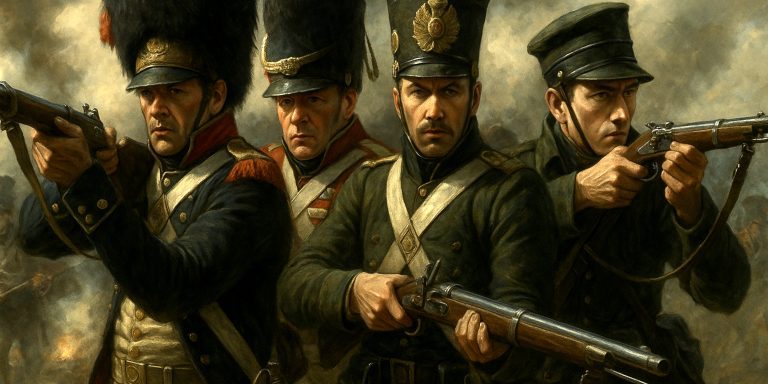
The US Model 1852 Naval Officer’s Sword has served as a proud emblem of the United States Navy for more than a century and a half. First standardised in 1852, it replaced a variety of inconsistent officer sidearms with a single, regulation design. While originally intended for combat, it quickly became a ceremonial and symbolic weapon, representing naval honour, discipline, and heritage.
Specification
| Feature | Detail |
|---|---|
| Origin | United States |
| Type | Naval officer’s sword |
| Adopted | 1852 |
| Blade Length | Approx. 30–32 inches (76–81 cm) |
| Blade Type | Slightly curved single-edged blade with narrow fuller |
| Hilt | Gilded brass with eagle pommel and half-basket guard featuring fouled anchor motif |
| Grip | White or black ray/sharkskin wrapped with twisted wire |
| Scabbard | Black leather (early) or polished metal (later), with brass fittings |
| Weight | Around 1.5–2 lbs (0.7–0.9 kg) |
| Current Use | Ceremonial dress sword of US Navy officers |
History and Evolution
The Model 1852 was introduced at a time when the US Navy sought standardisation in its dress and arms. The design drew heavily on earlier French and British naval swords but incorporated distinctly American symbols such as the eagle and fouled anchor.
- 1852–1865 (Civil War period): Early examples were functional weapons with robust blades, used at sea and during landing operations.
- Late 19th century: Transitioned to a primarily ceremonial role as naval warfare modernised and hand-to-hand combat became obsolete.
- 1900–1945: Variants continued through both World Wars, maintaining the same design with minor changes to materials and craftsmanship.
- Post-1945 to present: The sword remains part of formal naval attire, issued to officers and midshipmen, symbolising continuity and duty.
The basic design has endured, making it one of the longest-serving military sword patterns still in use.
Advantages
- Elegant and instantly recognisable design symbolising naval heritage.
- Light and well-balanced, easy to wear on dress occasions.
- Excellent craftsmanship, especially in 19th-century examples.
- Strong collector appeal due to long service history.
Disadvantages
- Not a practical weapon in modern combat terms.
- Early blades, while functional, were light and lacked true cutting power compared to cavalry sabres.
- Brass fittings are prone to tarnish and damage if improperly stored.
Comparison with Similar Weapons
| Sword | Nation | Period | Distinctive Features | Comparison |
|---|---|---|---|---|
| British 1827 Naval Officer’s Sword | United Kingdom | 1827–present | Similar fouled anchor guard, lion pommel | The British model directly inspired the US 1852, but the American version replaced the lion with an eagle and adopted a slightly slimmer blade. |
| French Naval Officer’s Sword (Model 1837) | France | 1837–1855 | Heavier blade, ornate guard | The French design influenced both British and American naval swords; the US model simplified its aesthetics for practicality. |
| US Model 1860 Light Cavalry Sabre | United States | 1860–1906 | Longer, curved blade for mounted combat | The cavalry sabre was a combat weapon, while the 1852 naval sword was lighter and more symbolic in use. |
Legacy
The Model 1852 remains a visible link between the Navy’s past and present. Carried during commissioning ceremonies, graduations, and official parades, it represents duty and service more than combat. Many naval academies and officers’ clubs still display these swords as heirlooms. The pattern’s longevity reflects the Navy’s respect for continuity and tradition.
Where to See
- United States Naval Academy Museum (Annapolis, Maryland): Extensive collection of naval swords including early 1852 models.
- National Museum of the U.S. Navy (Washington, D.C.): Displays examples from the Civil War through World War II.
- Private maritime collections and antique arms fairs often feature well-preserved pieces.
Collector’s Guide
What to Look For:
- Early Civil War-era blades with maker marks such as Ames Mfg Co., Horstmann, or Tiffany & Co.
- Original gilding on brass hilt and fittings.
- Intact leather or metal scabbard with correct mounts.
- Provenance to a named officer greatly increases value.
Condition Grades:
- Excellent: Full gilt, minimal wear, complete scabbard.
- Good: Some tarnish and wear, partial gilt.
- Fair: Missing scabbard parts, replaced grip wire or damage.
Typical Auction Prices (2025 estimates):
| Era | Condition | Price Range (GBP) |
|---|---|---|
| Civil War period (1850s–1860s) | Excellent | £1,200–£2,000 |
| Late 19th century | Good | £700–£1,100 |
| Early 20th century | Fair to Good | £400–£800 |
| Modern ceremonial | New | £300–£500 |
Authentic 19th-century examples with officer provenance can exceed £3,000, especially when paired with period photographs or documents.
Summary
Though its edge has long been ceremonial, the design of this sword endures as a testament to the Navy’s heritage, bridging the age of sail with the era of aircraft carriers. For collectors, it remains one of the most elegant and historically resonant American military swords ever produced.



